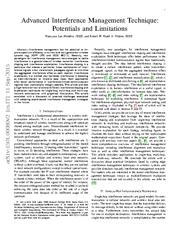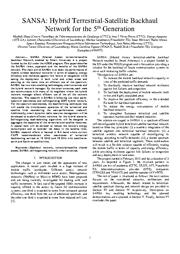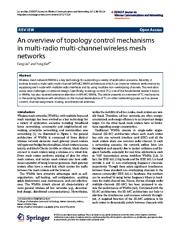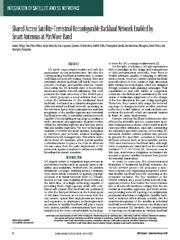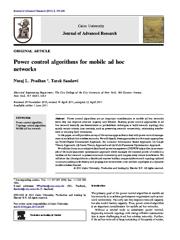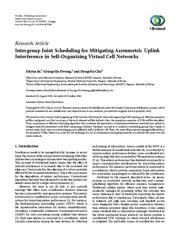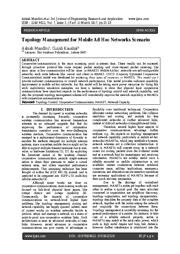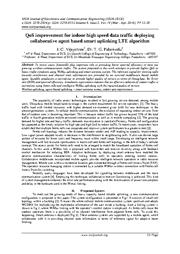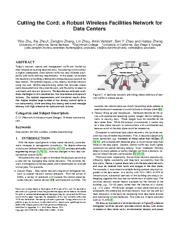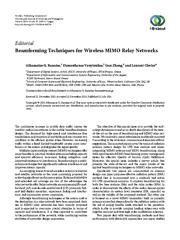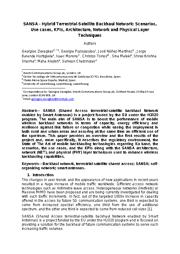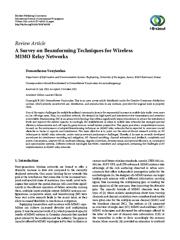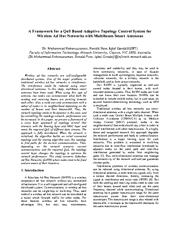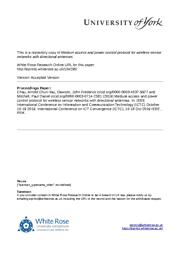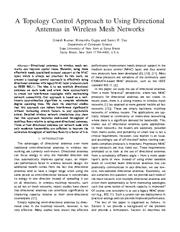A copy of this work was available on the public web and has been preserved in the Wayback Machine. The capture dates from 2019; you can also visit the original URL.
The file type is application/pdf.
Filters
Advanced Interference Management Technique: Potentials and Limitations
[article]
2015
arXiv
pre-print
The article concludes with a discussion of practical challenges associated with adopting sophisticated interference management strategies in the future. ...
Recently, new paradigms for interference management have emerged to tackle interference in a general class of wireless networks: interference shaping and interference exploitation. ...
Finding the optimal solution for the topological interference management problem is challenging for the K-user interference channel with an arbitrary network connectivity. ...
arXiv:1501.00080v2
fatcat:wvu63w4qmrghvjlkrysqub2hre
Sansa: Hybrid Terrestrial-Satellite Backhaul Network For The 5Th Generation
2016
Zenodo
By the smart antennas, each node can communicate with many of its neighbors where the hybrid network manager allows efficient use of the all the network resources. ...
SANSA has two main enabling technologies, smart antennas and the hybrid network manager. ...
which allows to realistically include the interferences between the multiple links as well. ...
doi:10.5281/zenodo.58444
fatcat:l3bs3vw5nzahzn3y2tcm7ntubq
An overview of topology control mechanisms in multi-radio multi-channel wireless mesh networks
2012
EURASIP Journal on Wireless Communications and Networking
and directional antennas. ...
Recently, it evolves toward a multi-radio multi-channel (MR-MC) WMN architecture, which can improve network performance by equipping each node with multiple radio interfaces and by using multiple non-overlapping ...
Therefore, proper modeling schemes are required in designing MR-MC WMNs with directional antennas. An MR-MC WMN using multiple directional antennas is proposed in [49] . ...
doi:10.1186/1687-1499-2012-324
fatcat:tffhsyl45felflkidsiavdqn5u
Shared Access Satellite-Terrestrial Reconfigurable Backhaul Network Enabled by Smart Antennas at MmWave Band
2018
IEEE Network
The two technological enablers of SANSA are smart antenna techniques at mmWave and software defined intelligent hybrid network management. ...
Its key principles are seamless integration of the satellite segment into terrestrial backhaul networks, a terrestrial wireless network capable of reconfiguring its topology according to traffic demands ...
antennas providing network topology reconfiguration and spatial interference mitigation. ...
doi:10.1109/mnet.2018.1800030
fatcat:k4zpr6yagbhh7llfqkmtluel4a
Power control algorithms for mobile ad hoc networks
2011
Journal of Advanced Research
In this paper, we will provide a survey of the various approaches to deal with power control management in mobile ad-hoc wireless networks. ...
connectivity, minimizing interference or securing QoS constraints. ...
Network topology with power control, with DDISPOW and equal energy consuming network with common node power.
Table 1 1 Distributed power management algorithm (DISPOW). ...
doi:10.1016/j.jare.2011.04.009
fatcat:7cupaqzbwrg7laqffacxilgrt4
Intergroup Joint Scheduling for Mitigating Asymmetric Uplink Interference in Self-Organizing Virtual Cell Networks
2016
Mobile Information Systems
Each user in a scheduling group is affiliated with a different cell. Then, the intercell groups are managed efficiently in the proposed VCNs. ...
Then, we propose an efficient scheduling algorithm that considers the asymmetry of interference between downlink and uplink to mitigate intercell interference with little computing overhead. ...
One user associates with only one antenna in this case. However, each cell can be managed by a common high-level BS controller for interference mitigation. ...
doi:10.1155/2016/9692051
fatcat:yuwacbpglrfrna763eg6o3bzvi
Topology Management for Mobile Ad Hoc Networks Scenario
2017
International Journal of Engineering Research and Applications
control and network capability, and also the proposed topology management scheme will considerably improve the network capability in MANETs with cooperative communications. ...
taking more power resources for doing this work. exploitation simulation examples, we have a tendency to show that physical layer cooperative communications have important impacts on the performance of topology ...
Cooperative communication has emerged as a replacement dimension of diversity to emulate the methods designed for multiple antenna systems, since a wireless mobile device might not be able to support multiple ...
doi:10.9790/9622-0703022528
fatcat:df7zilsaujhhrcrjgobqeqraey
QoS improvement for indoor high speed data traffic deploying collaborative agent based smart uplinking LTE algorithm
2014
IOSR Journal of Electronics and Communication Engineering
Wireless uplinking, agent based uplinkingsmart antenna wimax, indoor qos improvement ...
The reference signal for steering nulls towards interference and channel state information are provided by an external middleware based mobile agent. ...
Fig 7 illustrates the minimization of fading with multiple antenna array system at the transmitter and at receiver. ...
doi:10.9790/2834-09245358
fatcat:cefefbmu4fagbi6bj3vsm7wmeu
Cutting the cord
2014
Proceedings of the 20th annual international conference on Mobile computing and networking - MobiCom '14
Today's network control and management traffic are limited by their reliance on existing data networks. ...
We describe our solutions to address challenges in link coordination, link interference and network failures. ...
We focus on impact of path length and self-interference on each path, and interference between multiple paths. ...
doi:10.1145/2639108.2639140
dblp:conf/mobicom/ZhuZZZVZZ14
fatcat:xh6wby22rzcozktztd3qi3ri6m
Beamforming Techniques for Wireless MIMO Relay Networks
2014
International Journal of Antennas and Propagation
Multiple-input multiple-output (MIMO) techniques offer many benefits in practical wireless systems including capacity and spectral efficiency increment, fading mitigation, and improved resistance to interference ...
Two papers deal with beamforming methods and their performance with distinctive approaches; one paper studies the optimum placement of the antenna elements in a given area that can maximize the ergodic ...
Two papers deal with beamforming methods and their performance with distinctive approaches; one paper studies 2 International Journal of Antennas and Propagation the optimum placement of the antenna elements ...
doi:10.1155/2014/354714
fatcat:fexehyw2xfanva5ne4kcdidtz4
SANSA-hybrid terrestrial-satellite backhaul network: scenarios, use cases, KPIs, architecture, network and physical layer techniques
2017
International Journal of Satellite Communications And Networking
band is in the order of 20 Km. The majority of antennas for P2P links have 3-4 degrees of beamwidth. The terrestrial antenna gains are usually around 32-39 dBi. The satellite air interface used ...
Based on the project objectives that have been presented in the introduction, the following use cases have been identified for SANSA [41]: Radio link failure: In case a backhaul link fails, the network topology ...
in single node to multi-node multiple antenna system. ...
doi:10.1002/sat.1207
fatcat:pwlbridhg5bw7bckgpo5ghszla
A Survey on Beamforming Techniques for Wireless MIMO Relay Networks
2013
International Journal of Antennas and Propagation
Different network topologies have been considered and categorized, pertaining the challenges of BF implementation in MIMO relay networks. ...
Thus, in a multitier network, the demand for high-speed and interference-free transmission and reception is inevitable. ...
Following the first topology, there are several papers dealing with a new cooperative interference management scheme named interference neutralization. ...
doi:10.1155/2013/745018
fatcat:vclhrye455aedj3fsin43j3cqm
A Framework for a QoS Based Adaptive Topology Control System for Wireless Ad Hoc Networks with Multibeam Smart Antennas
2008
2008 IEEE International Symposium on Parallel and Distributed Processing with Applications
One of the major problems in traditional wireless ad hoc networks is interference. The interference could be reduced using smart directional antennas. ...
In this paper, we present a framework of a cross layer approach of topology control that interacts with the Routing layer and MAC layer and meets the required QoS of different data streams. ...
avoid interference with other transmissions. ...
doi:10.1109/ispa.2008.107
dblp:conf/ispa/RokonuzzamanPG08a
fatcat:iiez5vgbqjcohmcnbgcrj3ylbe
Medium Access and Power Control Protocol for Wireless Sensor Networks with Directional Antennas
2019
2019 International Conference on Information and Communication Technology Convergence (ICTC)
The protocol helps improve throughput and reduce energy consumption by maximising spatial reuse and with a strategy to deal with overlap between antenna patterns without any additional complexity at the ...
Good fairness is demonstrated and throughput for a 4-antenna system is 2.17 times that of a single antenna system. ...
or having the multiple antennas operating in different frequency bands [6, 8] . ...
doi:10.1109/ictc46691.2019.8939806
dblp:conf/ictc/ChauDM19
fatcat:nfnlwhpqubeepbdtihspeso7oq
A Topology Control Approach to Using Directional Antennas in Wireless Mesh Networks
2006
2006 IEEE International Conference on Communications
The idea is to use multiple directional antennas on each node and orient them appropriately to create low interference topologies while maintaining network connectivity. ...
In this work, we present a topology control approach to effectively using directional antennas with legacy MAC layer protocols such as IEEE 802.11. ...
Essentially, we ask ourselves this question: can we provide each node of the mesh network with multiple directional antennas and orient them appropriately to form interesting topologies such that some ...
doi:10.1109/icc.2006.255720
dblp:conf/icc/KumarGD06
fatcat:w5e4khuotffajbxm3oeva5f2zy
« Previous
Showing results 1 — 15 out of 13,064 results

